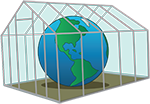Flying Papers.
Hold a regular sheet of
paper to your bottom lip (you may have to
play a bit to find the exact location) and
blow hard across the sheet. The sheet flies
up! This is the same reason airplanes can
fly. As you blow across the top of the sheet,
you lower the air pressure (because the air
is moving faster), and thus the pressure on
the underside of the sheet is now higher,
and higher air pressure pushes the sheet
upwards.
Kissing Balloons.
Blow up two balloons.
Attach a piece of sting to each balloon.
Have each hand hold one string so that the
balloons are at nose-level, 6" apart. Blow
hard between the balloons and watch them
move! The air pressure is lowered as you
blow between the balloons (think of the air
molecules as ping pong balls ... they balls
don't have enough time to touch the balloon
surface as they zoom by). The air
surrounding the balls that's not really
moving is now at a higher pressure, and
pushes the balloons together.
____________________________Egg in a bottle science experiment
The Egg in a Bottle experiment illustrates the effects of air pressure.
Air pressure is manifested in different phenomena, so are its effects.
When
it comes to weather, air pressure plays a big role too. Most of the
changes in a particular place's weather are governed by air pressure.
In
this experiment, you will learn more about air pressure and its
behaviour by putting an egg into a bottle and taking it out again
without destroying theCan you figure out why the egg gets sucked into the neck of the bottle?
What you need
- 1 x hard boiled egg
- 1 x glass bottle with a wide neck (just wide enough to sit the egg in)
- Boiled water from the kettle
Place the hard boiled egg so that it sits in the neck of the bottle.
Watch and wait. You will notice the egg gets shifted by the hot air in the bottle, this is when the hot air expands and escapes a bit.
The egg will eventually get sucked into the bottle.
Why is it so?
The hot air from the hot water expands and forces its way out of the bottle, making the egg shift around.As the air cools inside the bottle the air contracts and takes up less room. This creates lower pressure inside the bottle than outside. The greater pressure outside the bottle forces the egg into the bottle.
Hints and tips:
- To get the egg back out of the bottle, tilt the bottle and blow air into it. Watch out though, because the egg will shoot out of the bottle!





